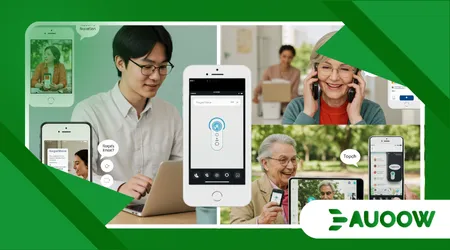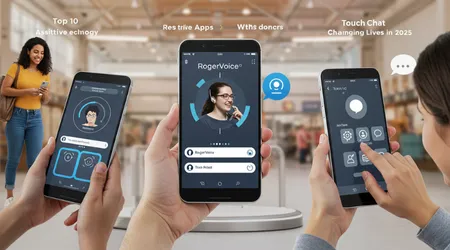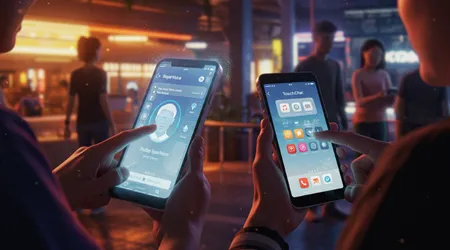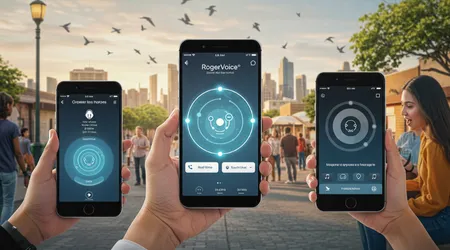Top 10 Assistive Apps Changing Lives in 2025

Assistive apps are revolutionizing accessibility, empowering millions with tools for independence and inclusion.
In 2025, technology drives unprecedented innovation, breaking barriers for people with disabilities.
From AI-powered navigation to real-time communication aids, these apps redefine daily life.
This article explores the top 10 assistive apps transforming lives, blending cutting-edge functionality with human-centered design.
Why settle for limitations when technology can unlock potential? Let’s dive into the future of accessibility.
The global assistive technology market is booming, projected to reach $31.8 billion by 2026, per Allied Market Research.
Smartphones, now ubiquitous, host assistive apps that cater to diverse needs vision, hearing, mobility, and cognition.
These tools aren’t just gadgets; they’re lifelines, fostering autonomy. Developers in 2025 prioritize inclusivity, leveraging AI, machine learning, and user feedback.
This curated list highlights apps making tangible impacts, with real-world examples and insights. Ready to explore the game-changers?
1. Be My Eyes: Virtual Vision for the Visually Impaired
Be My Eyes connects visually impaired users with sighted volunteers via live video. In 2025, its AI upgrade describes surroundings instantly.
Imagine a blind student, Sarah, navigating a campus cafeteria. The app’s assistive app feature identifies food options, ensuring independence.
With 7 million volunteers globally, it’s a community-driven marvel.
The app’s AI now recognizes objects and text in real time, reducing reliance on human volunteers. Sarah uses it to read labels, avoiding dietary mishaps.
++ Smart Glasses for the Deaf: What’s New in 2025
Its intuitive interface ensures accessibility for all ages. Why struggle with isolation when a global network awaits?
Integration with smart glasses in 2025 enhances functionality. Users like Sarah pair Be My Eyes with AR devices for hands-free navigation.
The app’s commitment to privacy, with encrypted calls, builds trust. It’s not just an app it’s a bridge to inclusion.

2. Soundscape: Sonic Navigation for the Blind
Microsoft’s Soundscape uses 3D audio to guide visually impaired users. In 2025, its assistive app maps routes with spatial sound cues.
Picture Tom, a blind professional, commuting in London. Soundscape’s audio beacons highlight crosswalks, boosting confidence.
The app integrates with GPS and LiDAR for precise navigation. Tom hears real-time alerts about obstacles, like construction zones. Its offline mode ensures reliability in rural areas.
Accessibility shouldn’t depend on Wi-Fi, right?
Soundscape’s open-source approach invites developer tweaks, tailoring it to local needs. Tom customizes audio cues for his favorite café.
With 500,000 active users, per Microsoft’s 2024 report, Soundscape proves audio can rival visual navigation.
3. Ava: Real-Time Captions for the Deaf
Ava delivers live captions for conversations, vital for deaf users. In 2025, this assistive app boasts 95% transcription accuracy.
Consider Maria, a deaf student, attending lectures. Ava transcribes professor’s words instantly, ensuring she keeps up.
The app supports group chats, identifying speakers via voice recognition. Maria uses it in study groups, fostering inclusion.
Its multilingual feature, now covering 20 languages, breaks global barriers. Communication should be universal, shouldn’t it?
Read more: Electronic Braille: what it is and how it’s being used
Ava’s integration with Zoom and Teams enhances workplace accessibility. Maria joins virtual meetings confidently, with captions syncing seamlessly.
Free for basic use, its premium version unlocks advanced features, making it a must-have.
4. WheelMate: Accessibility Mapping for Mobility
WheelMate helps wheelchair users find accessible locations. In 2025, this assistive app crowdsources data on ramps and elevators.
Take John, a wheelchair user, exploring New York. WheelMate pinpoints accessible restrooms, easing his travels.
With 100,000 mapped locations globally, per Coloplast’s 2024 update, it’s a game-changer. John adds a new café’s accessibility details, helping others.
The app’s offline caching ensures functionality anywhere. Mobility shouldn’t limit adventure.
WheelMate’s community-driven model thrives on user input. John rates venues, refining the database.
Its AR feature overlays accessibility info on maps, blending tech with practicality. It’s like a GPS for inclusion.
5. Seeing AI: All-in-One Vision Aid

Microsoft’s Seeing AI is a Swiss Army knife for the blind. In 2025, this assistive app scans documents, faces, and scenes.
Imagine Lisa, visually impaired, shopping. Seeing AI reads prices aloud, ensuring she’s not overcharged.
The app’s facial recognition identifies friends, adding social ease. Lisa uses its currency reader for cash transactions.
Supporting 30 languages, it’s globally inclusive. Independence shouldn’t be a luxury, right?
Seeing AI’s offline mode and voice-command interface make it user-friendly. Lisa customizes settings for her needs, like louder narration.
With 1 million downloads, it’s a cornerstone of assistive tech, blending AI with empathy.
6. Voiceitt: Speech Recognition for Non-Standard Voices
Voiceitt translates atypical speech for those with neurological conditions. In 2025, this assistive app integrates with smart home devices.
Picture Emma, with cerebral palsy, controlling lights via Voiceitt. Her unique voice is understood perfectly.
The app learns user speech patterns, improving accuracy. Emma uses it for virtual assistant commands, gaining autonomy.
Its 90% recognition rate, per Voiceitt’s 2024 trials, is groundbreaking. Communication barriers should crumble, not persist.
Voiceitt’s enterprise version aids workplaces, letting Emma join Teams calls. Its privacy-first design encrypts data, ensuring trust.
By amplifying unique voices, it redefines assistive technology’s potential.
7. RogerVoice: Phone Calls for the Deaf
RogerVoice enables phone calls with real-time captions for deaf users. In 2025, this assistive app supports video calls too.
Consider Alex, deaf, booking appointments. RogerVoice transcribes calls, ensuring clarity.
The app’s AI transcription rivals human accuracy, covering 15 languages. Alex uses it for family calls, strengthening bonds.
Its low-latency design minimizes delays. Connection shouldn’t exclude anyone, should it?
RogerVoice’s free tier offers 30 minutes monthly, with premium plans for heavy users.
Alex pairs it with Bluetooth hearing aids for seamless use. It’s a lifeline for deaf communication.

8. Braina: Cognitive Support for Neurodiverse Users
Braina aids those with cognitive disabilities via voice-controlled tasks. In 2025, this assistive app schedules reminders and reads texts.
Picture Sam, with autism, managing his day. Braina’s prompts keep him on track.
The app’s natural language processing understands casual speech. Sam sets alarms with simple phrases, reducing stress.
Its offline mode ensures reliability. Cognitive support should be intuitive, right?
Braina’s customizable interface adapts to user needs. Sam adjusts fonts for readability, enhancing usability.
With 200,000 users, per Braina’s 2024 data, it’s transforming neurodiverse lives.
9. Envision AI: Smart Glasses Companion
Envision AI enhances smart glasses for the visually impaired. In 2025, it describes environments in real time.
Imagine Clara, blind, at a museum. This assistive app narrates exhibits, enriching her experience.
The app’s text-to-speech reads signs instantly. Clara uses it to navigate airports, avoiding delays.
Its lightweight design suits all-day wear. Exploration shouldn’t exclude the blind, should it?
Envision’s integration with Google Glass boosts precision. Clara customizes audio feedback for clarity. With a 2024 award from the Zero Project, it’s a leader in assistive innovation.
10. TouchChat: AAC for Non-Verbal Users
TouchChat provides augmentative communication for non-verbal individuals. In 2025, it offers customizable symbol boards.
Picture Liam, with autism, expressing needs. TouchChat’s assistive app gives him a voice.
The app supports 10,000+ symbols, per PRC-Saltillo’s 2024 report. Liam builds sentences quickly, reducing frustration. Its cloud backup syncs across devices. Expression should be limitless, right?
TouchChat’s voice output mimics natural speech. Liam uses it in school, engaging peers. Its intuitive design empowers young users, fostering inclusion.
| App Name | Primary Function | Key Feature | User Base (2024) |
|---|---|---|---|
| Be My Eyes | Visual assistance | AI scene description | 7 million volunteers |
| Soundscape | Audio navigation | 3D spatial audio | 500,000 users |
| Ava | Live captions | 95% accuracy | Not disclosed |
| WheelMate | Accessibility mapping | Crowdsourced data | 100,000 locations |
| Seeing AI | Multi-tool vision aid | Facial recognition | 1 million downloads |
| Voiceitt | Speech translation | 90% accuracy | Not disclosed |
| RogerVoice | Call captions | Video call support | Not disclosed |
| Braina | Cognitive support | Voice tasks | 200,000 users |
| Envision AI | Smart glasses aid | Real-time narration | Not disclosed |
| TouchChat | AAC communication | 10,000+ symbols | Not disclosed |
The Future of Assistive Apps: Trends to Watch
Beyond these apps, 2025 heralds trends like AI personalization and cross-platform integration.
Assistive apps will leverage 5G for faster responses, enhancing real-time aids. Wearable tech, like smart gloves, will sync with apps, aiding motor-impaired users.
Governments, per the UN’s 2024 disability report, are mandating accessibility, spurring innovation.
Developers now prioritize co-design with disabled communities. This ensures apps like Be My Eyes evolve with user needs.
Open-source platforms, like Soundscape, invite global tweaks, democratizing access. The future isn’t just tech it’s collaboration.
Privacy remains critical as assistive apps handle sensitive data. End-to-end encryption, as in Voiceitt, sets the standard.
Meanwhile, affordability improves, with free tiers expanding access. The horizon glows with promise accessibility is no longer an afterthought.
Conclusion: A World Without Barriers
The top 10 assistive apps of 2025 aren’t just tools they’re catalysts for dignity and independence.
From Be My Eyes’ global community to TouchChat’s expressive power, they reshape lives.
Consider Jane, a deaf artist, using Ava to pitch her work, or Mike, a wheelchair user, exploring cities with WheelMate. These apps bridge gaps, proving technology can amplify humanity.
As 2025 unfolds, assistive apps will only grow smarter, more inclusive, and more intuitive. They challenge us to rethink accessibility not as charity, but as a right.
Let’s champion these innovations, ensuring no one is left behind. The future is accessible, and it’s already here.
Frequently Asked Questions
Q: How do assistive apps ensure user privacy?
A: Apps like Voiceitt use end-to-end encryption, safeguarding sensitive data. Developers prioritize GDPR compliance, ensuring trust.
Q: Are assistive apps affordable for low-income users?
A: Many, like Ava and RogerVoice, offer free tiers. Subsidies from NGOs, per the UN’s 2024 report, further expand access.
Q: Can assistive apps work offline?
A: Yes, apps like Soundscape and Seeing AI cache data for offline use, ensuring reliability in low-connectivity areas.
Examples
- Sarah’s Story: Sarah, a blind student, uses Be My Eyes to navigate her college campus, identifying lecture halls and cafeterias independently.
- John’s Journey: John, a wheelchair user, relies on WheelMate to explore Tokyo, finding accessible venues and contributing to its global database.
Statistic
The assistive technology market will hit $31.8 billion by 2026, driven by app innovation (Allied Market Research, 2024).
Analogy
Assistive apps are like keys to a locked city each unlocks doors to education, work, and connection, letting everyone roam freely.
